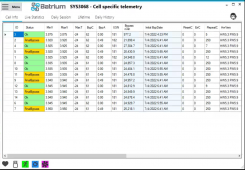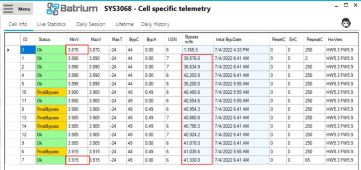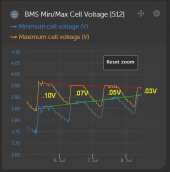sunshine_eggo
Happy Breffast!
It has been years in the making, but I finally have the NMC battery poised for deployment... (okay, only half, but still).
Summary:
7X Ford Fusion/C-Max Energi PHEV batteries, 7.6kWh rated per pack.
Each battery: 84S 25Ah 3.7V NMC cells. Four subpacks of 21S in series
Packs have tested 19-24Ah
28 total subpacks (modules), packs of 4 pictured below:

Config:
21S modules disassembled, cells flipped to the same polarity and reassembled into a 21P module.
Cells connected with custom Aluminum bus bars (.25" x 1"), 21 holes each, 2 per module, 28 bus bars, 588 holes.
Each 21P module in series with other 21P modules for a total of 14S.
21P module with bus bars fit:

So far, I have 14 of the 28 modules ready to go - 1/2 the bank and enough to build a single 21P14S battery. That's 48V, Baby! 26.6kWh rated and about 23kWh actual based on tests.
note that these 14 modules have roughly equal numbers of cells from each pack such that each 21P module has almost identical capacity to the other modules in series.
No. I shouldn't have used copper. Raw materials alone would have been $2000 for copper bus bars with no holes. The Aluminum bus bars were $995 TOTAL with the holes drilled in them.
Anyway, the biggest challenge has been being remote. With everything at the site, but me only there ~12-18 times a year, it turned out to be nearly impossible to put in the many hours of work needed to get it done, plus my used T-1275 4S2P 48V bank was more than meeting our needs... wanted to enjoy that shit too! I brought much of it back and started working it at home.
Batrium acquired for Victron interface and cell data logging. I've been intimidated by the Batrium from the start. There's no manual per se, but a crapton of info scattered about. What I finally figured out is that everything is in videos, and if you really dig in, you can simply queue up a series of videos and get everything configured.
TRIAL RUN:
With everything pretty much ready to install, I didn't want to get up there and realize that I was missing something, or I couldn't figure something out, etc., so I did a trial run with the Batrium on an as-pulled module using 14 out of the 21S cells:
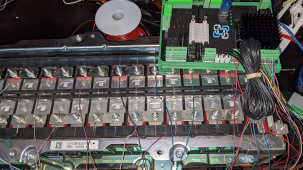
Yes, it's a mess, but I was going for function.
Success:
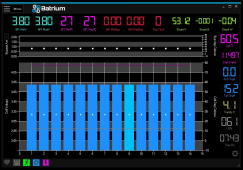
Keep in mind that this is NMC, NOT LFP. Voltage and SoC have a strong correlation with this chemistry, so balancing at any point in the voltage curve is worthwhile. My own charging efforts with a hobby charger capable of 7S 3.7V balancing got the cells to within 3.80-3.82. I tested the balancing function by setting it to 3.80, and it only took about an hour to pull them all down to 3.80V at a max of 0.5A.
The cool thing is it documented how much was required to balance them:
This was taken from a snapshot created every 15 minutes. It was towards the end after all but #13 had been balanced.
I'm running the software on a Mini PC. It seems to handle it just fine, and it only uses 18W peak power based on the power brick output rating. I still have a lot to figure out about logging, but it looks like I can get there. Remote access to the PC appears to work well too.
Lessons learned:
Next week will include a post documenting success or a magnificent fire in a shipping container.
Thanks for reading/skimming/laughing quietly to yourself, etc.
Summary:
7X Ford Fusion/C-Max Energi PHEV batteries, 7.6kWh rated per pack.
Each battery: 84S 25Ah 3.7V NMC cells. Four subpacks of 21S in series
Packs have tested 19-24Ah
28 total subpacks (modules), packs of 4 pictured below:

Config:
21S modules disassembled, cells flipped to the same polarity and reassembled into a 21P module.
Cells connected with custom Aluminum bus bars (.25" x 1"), 21 holes each, 2 per module, 28 bus bars, 588 holes.
Each 21P module in series with other 21P modules for a total of 14S.
21P module with bus bars fit:

So far, I have 14 of the 28 modules ready to go - 1/2 the bank and enough to build a single 21P14S battery. That's 48V, Baby! 26.6kWh rated and about 23kWh actual based on tests.
note that these 14 modules have roughly equal numbers of cells from each pack such that each 21P module has almost identical capacity to the other modules in series.
No. I shouldn't have used copper. Raw materials alone would have been $2000 for copper bus bars with no holes. The Aluminum bus bars were $995 TOTAL with the holes drilled in them.
Anyway, the biggest challenge has been being remote. With everything at the site, but me only there ~12-18 times a year, it turned out to be nearly impossible to put in the many hours of work needed to get it done, plus my used T-1275 4S2P 48V bank was more than meeting our needs... wanted to enjoy that shit too! I brought much of it back and started working it at home.
Batrium acquired for Victron interface and cell data logging. I've been intimidated by the Batrium from the start. There's no manual per se, but a crapton of info scattered about. What I finally figured out is that everything is in videos, and if you really dig in, you can simply queue up a series of videos and get everything configured.
TRIAL RUN:
With everything pretty much ready to install, I didn't want to get up there and realize that I was missing something, or I couldn't figure something out, etc., so I did a trial run with the Batrium on an as-pulled module using 14 out of the 21S cells:

Yes, it's a mess, but I was going for function.
Success:

Keep in mind that this is NMC, NOT LFP. Voltage and SoC have a strong correlation with this chemistry, so balancing at any point in the voltage curve is worthwhile. My own charging efforts with a hobby charger capable of 7S 3.7V balancing got the cells to within 3.80-3.82. I tested the balancing function by setting it to 3.80, and it only took about an hour to pull them all down to 3.80V at a max of 0.5A.
The cool thing is it documented how much was required to balance them:
| Cell | Date | Time | Session | Amp | MinV | MaxV | ||
1 | 7/1/2022 | 1:06:43 | AM | 336.5 | mAh | 0.00A | 3.80v | 3.80v |
2 | 7/1/2022 | 1:06:43 | AM | 254.5 | mAh | 0.00A | 3.80v | 3.80v |
3 | 7/1/2022 | 1:06:43 | AM | 213.1 | mAh | 0.00A | 3.80v | 3.80v |
4 | 7/1/2022 | 1:06:43 | AM | 394.2 | mAh | 0.00A | 3.80v | 3.80v |
5 | 7/1/2022 | 12:39:20 | AM | 309 | mAh | 0.00A | 3.80v | 3.80v |
6 | 7/1/2022 | 12:39:19 | AM | 333.1 | mAh | 0.00A | 3.80v | 3.80v |
7 | 7/1/2022 | 1:06:43 | AM | 240.6 | mAh | 0.00A | 3.80v | 3.80v |
8 | 7/1/2022 | 1:06:43 | AM | 221.4 | mAh | 0.00A | 3.80v | 3.80v |
9 | 7/1/2022 | 1:06:43 | AM | 82.1 | mAh | 0.00A | 3.80v | 3.80v |
10 | 7/1/2022 | 12:39:19 | AM | 4.6 | mAh | 0.00A | 3.80v | 3.80v |
11 | 7/1/2022 | 12:39:20 | AM | 177.3 | mAh | 0.00A | 3.80v | 3.80v |
12 | 7/1/2022 | 1:06:43 | AM | 410.4 | mAh | 0.00A | 3.81v | 3.81v |
13 | 7/1/2022 | 1:06:43 | AM | 589.4 | mAh | 0.48A | 3.81v | 3.81v |
14 | 7/1/2022 | 1:06:43 | AM | 230.8 | mAh | 0.00A | 3.80v | 3.80v |
This was taken from a snapshot created every 15 minutes. It was towards the end after all but #13 had been balanced.
I'm running the software on a Mini PC. It seems to handle it just fine, and it only uses 18W peak power based on the power brick output rating. I still have a lot to figure out about logging, but it looks like I can get there. Remote access to the PC appears to work well too.
Lessons learned:
- My mouth/brain readily write checks my ass can't cash. Time estimates were woefully inadequate, and my ability to get shit done is a small fraction of what I think it is.
- Remote projects don't get done. This first half of the battery took the better part of 3 years. There were massive flurries of work spaced out with long periods of inactivity in between. The second half will likely be done faster (note how I didn't give an actual timeframe... I'm already learning).
- LFP would have been so much easier, faster and a little less in cost. I was fully committed with 5 of these packs before I became aware of any of the Amy's, EVE or their 280Ah cells. I would have been done two years ago in a day.
- Batriums MUST have a PC attached to log/access data.
- Drilling 21 holes in a .25" Al bus bar isn't easy. It's very time consuming. I did 7 bus bars, and it took me about an hour each. I contracted with an acquaintance with an end mill. He was able to do them 7-8 times faster (30 minutes to do 4 stacked) and so much more precise. I paid the equivalent of about $14/hour of my 21 hours it would have taken to finish, and I got 21 hours of my life back.
- #5 is simply a "Right tool and right person for the job" lesson. Just because I can do something doesn't mean I should.
Next week will include a post documenting success or a magnificent fire in a shipping container.
Thanks for reading/skimming/laughing quietly to yourself, etc.






